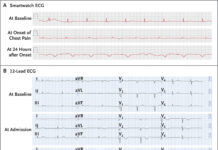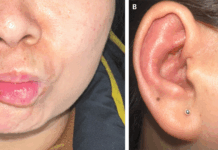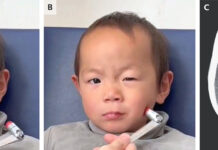Blood within the walls of the pregnant uterus of a 29-year-old woman without any trauma.
A 29-year-old primigravid female who was 33 weeks pregnant presented to the obstetric department with contractions. The patient had no water leak (rupture of membranes) or vaginal bleeding. The patient had no history of any recent trauma.
On pelvic examination, the uterine fundus was firm and tender.
Retroplacental hemorrhage was appreciated on transabdominal ultrasonography (Panel A). Fetal heart-rate tracing showed a nonreassuring pattern with deep variable decelerations.
A decision was made to perform an emergency cesarean section. During the operation, the uterus was bruised due to the infiltration of blood into the myometrium.
The extravasation of blood from the placental blood vessels into the myometrium (the middle layer of the uterine wall) of the uterus is called uteroplacental apoplexy or Couvelaire uterus (Panel B).
A working diagnosis of complicated concealed placental abruption was made.
Placental abruption is the premature separation of the placenta, which leads to hemorrhage. If the blood remains contained between the detached placenta and the uterus, without any per vaginal bleeding, it is called concealed placental abruption.
The blood may seep into the myometrium of the uterine wall (Couvelaire uterus), and rarely it can infiltrate the peritoneal cavity too. Couvelaire uterus is a rarely reported complication of placental abruption, which is accurately diagnosed on direct visualization and/or biopsy, explaining the underreported cases.
In such cases, i.e., concealed hemorrhage, there are chances of a delayed diagnosis due to delayed presentation, consequently leading to higher fetal morbidity and mortality. With placental abruption, there is a risk of intrauterine fetal death or hypoxic brain injury.
Postnatally, the neonate’s APGAR scores were 8 and 9 at 1- and 5- minutes, respectively. The patient was given carbetocin, oxytocin, misoprostol, and tranexamic acid. Her uterus was atonic after the C-section.
The child was under care due to prematurity but was soon discharged after recovering. The postoperative course of the mother remained uneventful, and she made a complete recovery without any long term complications.
The management of Couvelaire uterus is ideally conservative, and hysterectomy is discouraged.
References
Pradip Dashraath, M. a.-C. (2020, November 12). Couvelaire Uterus. Retrieved from The New England Journal of Medicine: https://www.nejm.org/doi/full/10.1056/NEJMicm2010749
Rathi M, Rathi SK, Purohit M, Pathak A. Couvelaire uterus. BMJ Case Rep. 2014;2014:bcr2014204211. Published 2014 Mar 31. DOI:10.1136/bcr-2014-204211




